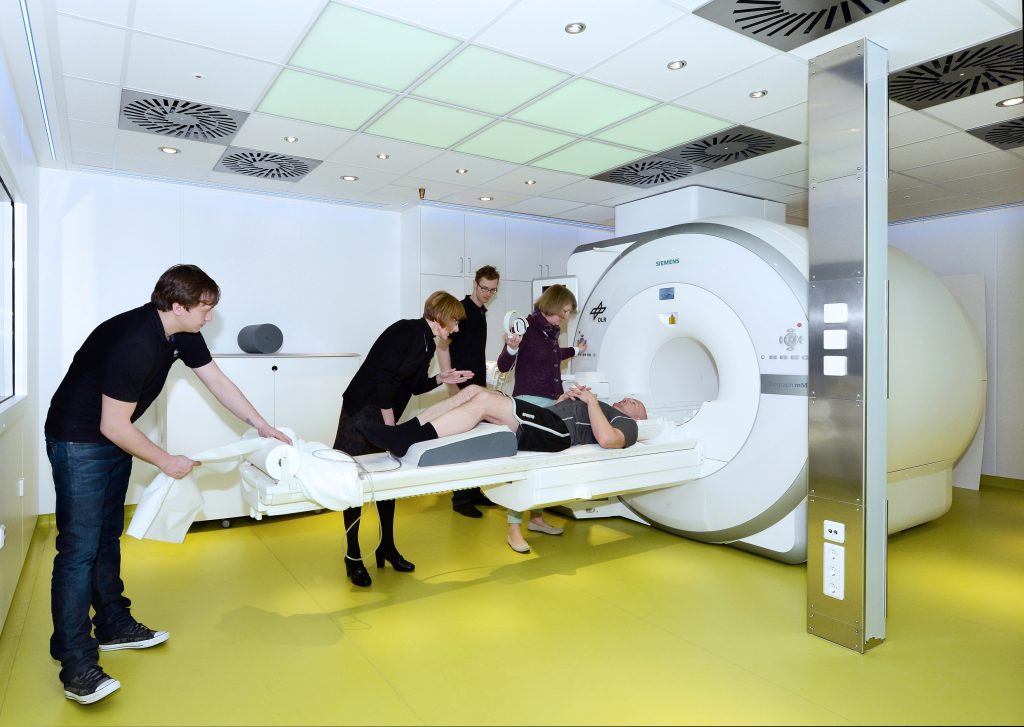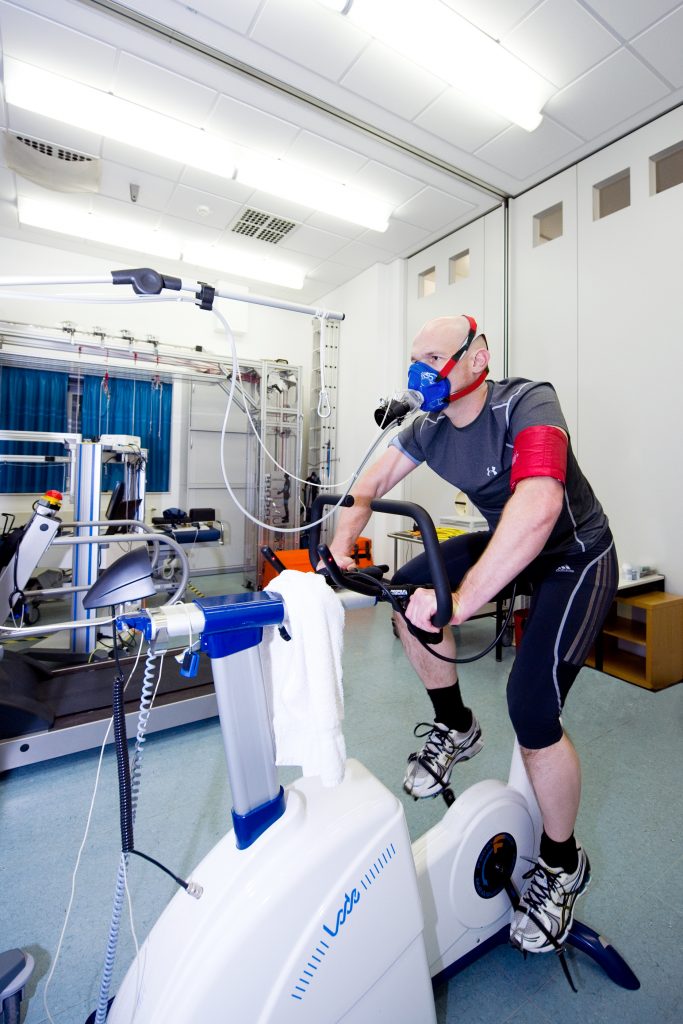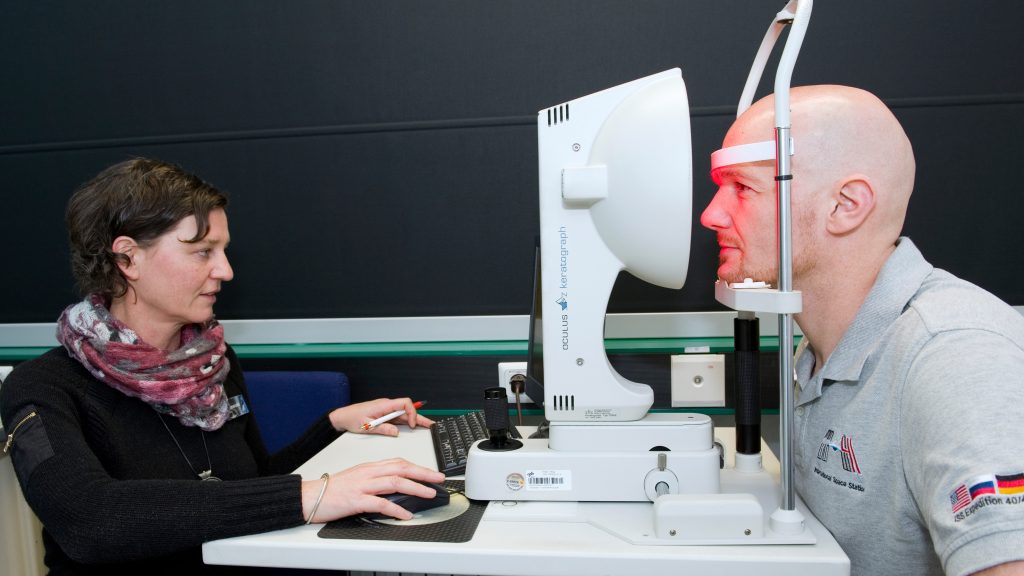“You do not have to be a top athlete to be an astronaut, but a good level of fitness is important,” says Alexander Gerst, describing the fitness requirements for an astronaut. In fact, a professional athlete would have greater problems during a long stay in weightlessness than somebody with a lower level of training. Top athletes often have an enlarged heart, which pumps more blood and, thus, more oxygen throughout the body during exercise. Complications can occur if the heart is not exercised with regular training. “At the moment, I am training for about six hours a week, mainly focusing on cardio fitness and muscle development, but also on the shoulder area and forearm muscles in preparation for the spacewalk,” adds Alexander. On the International Space Station (ISS) the astronauts train for roughly two hours per day, but muscle building is not possible. The training merely slows down muscle and bone mass loss, which is caused by the absence of weight-bearing in microgravity.
To tailor Alexander Gerst’s training plan for his time on the ISS to his requirements, he is undergoing detailed medical examinations prior to launch. At the end of February 2014, he completed the Pre-flight Medical at the DLR Institute of Aerospace Medicine in Cologne – this examination has always previously taken place at NASA’s Johnson Space Center (JSC) in Houston, USA.
One focus of the medical team, which consists of doctors from ESA and DLR, is the eye examination. Results from studies conducted on other astronauts suggest that weightlessness has a negative effect on vision; more research is required in this area. The examination includes Optical Coherence Tomography (OCT), ultrasound images of the eye as well as detailed images of the head using a Magnetic Resonance Imaging (MRI) scanner. During his mission on the ISS, Alexander Gerst will be carrying out ultrasound exams on his own eyes. When he returns to Earth in November 2014, a further examination will be carried out and the data compared. In total, there will be some 100 medical experiments during the ‘Blue Dot’ mission.

Magnetic Resonance Imaging is used to take a closer look at the head and eyes. Image credit: DLR, CC-BY 3.0
The examinations are anything but routine for the doctors taking part; the medical data for all of the astronauts is collected in a NASA database and must be comparable. On Earth, there are generally a large number of medical research test subjects that deliver scientifically valuable information. But as the number of astronauts and the time they spend in space is rather limited in comparison, the doctors have to be trained appropriately. It is important that the examinations are carried out using the same equipment in Houston and Cologne. For example, the MRI scanners used at DLR Cologne and NASA in Houston are identical. This guarantees that the data will be comparable. The DLR doctors are also in regular contact with their colleagues at JSC to replicate the NASA standard at the DLR Institute for Aerospace Medicine.
The results from the medical tests conducted at the end of the mission will be compared with the data acquired before and during the flight, enabling any changes to be accurately recognised and to plan for rehabilitation, so that Alexander Gerst will quickly get fit again.
Incidentally, the pre-flight checks also include a visit to the dentist. It would be a long wait for an emergency appointment if you got toothache at an altitude of 300 kilometres.






Discussion: 5 comments
Fascinating reading.
Here follows a COMMENt and then a QUESTION! hehe
COMMENT:
The more I read about the effects of time spent in the ISS (reading Chris Hadfield’s book among others) the more struck I am by the parallel between “symptoms” or weaknesses displayed by returning astronauts and those of us on earth who have developed parkinsonism/parkinson’s disease. I have been an amateur space-geek for a very long time, and years ago, long before parkinson’s, I was at the Kennedy Space Center and bought a book called “Astrofit”. When parkinson’s was triggered/accelerated in me by general anaesthesia, once I thought about exercise etc, I dug out my Astro Fit book and found its balance exercises particularly helpful.
Now when I read about inefficiencies in muscles etc in astronauts I think there is a real opportunity for some kind of exercise crossover … holding parkinson’s at bay seems to be enhanced by repatterning muscle memory, as well as full calisthenic and muscle training exercises.
QUESTION:
Please would you let me know how I may find out more details of the preparation (and subsequent rehab) of astronauts in relation to time in space?
Thank you!
Joanne
Hi Joanne,
take a look at the websites of ESA’s directorate of Human Spaceflight and Operations: https://www.esa.int/Our_Activities/Human_Spaceflight and ESA’s Astronaut Centre: https://www.esa.int/About_Us/EAC
These sites should be a good starting point.
For the blog team,
Andreas
Lieber Alexander,
für die Astronauten ist das größte Problem die fehlende Schwerkraft. Wernher von Braun hatte ja deshalb damals eine sich drehende Raumstation in Form eines Wagenrads vorgeschlagen, die durch die Rotation Gravitation erzeugt. Ich verstehe deshalb nicht, warum die ESA weiterhin auf die ISS besteht bzw. den Wünschen der USA für eine Verlängerung des Betriebs nachkommt. Wir Europäer brauchen endlich eine eigene Raumstation. Die ISS aber bitte nicht verschrotten, sondern in eine Umlaufbahn um den Mond schieben und/oder auf dem Mond aufsetzen lassen als erste internationale Mondstation natürlich dann entsprechend vor Ort nachgerüstet. Machbarbeikeitsstudie bitte in Auftrag geben, lieber CEO
Dear Dr. Gerst,
thank you for a very interesting reading. May I ask you: What are you supposed to do, when you or some of your colleagues have for example some serious abscess or when somebody breaks his leg? Are you able to do some basic or more complicated surgery during the mission? I wish you good luck and a safe flight!
With kind regards,
Jan
Hallo, ich habe Ihren Blogbeitrag gelesen, es war unglaublich, die Informationen, die Sie mit anderen geteilt haben, sind perfekt, da ich mit zusätzlichen Informationen aktualisiert werde.